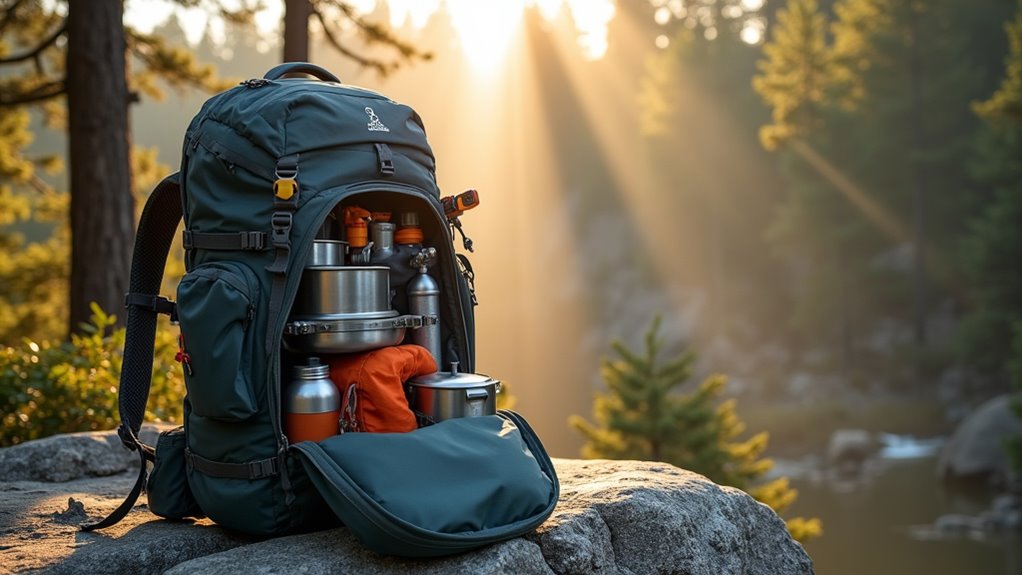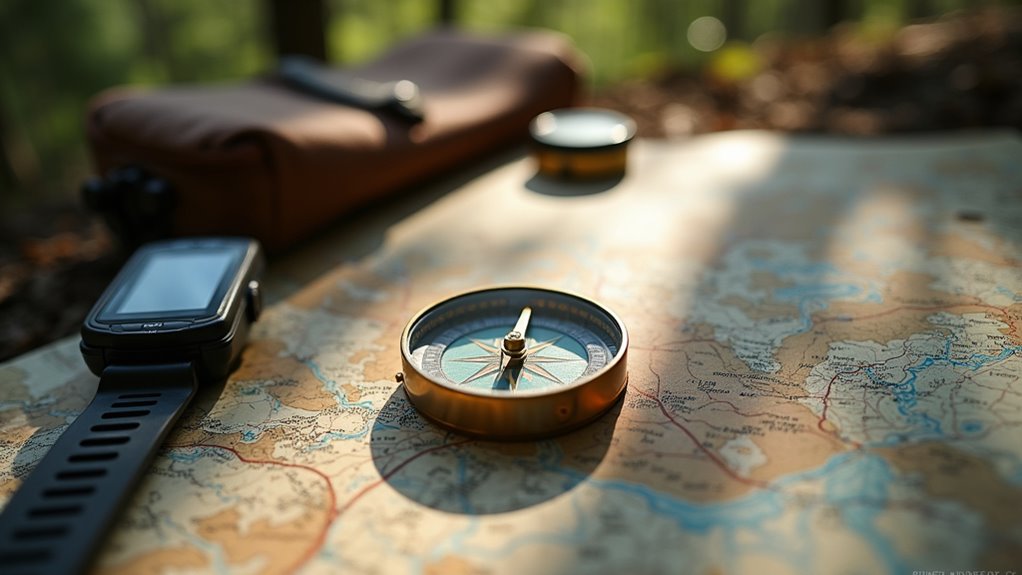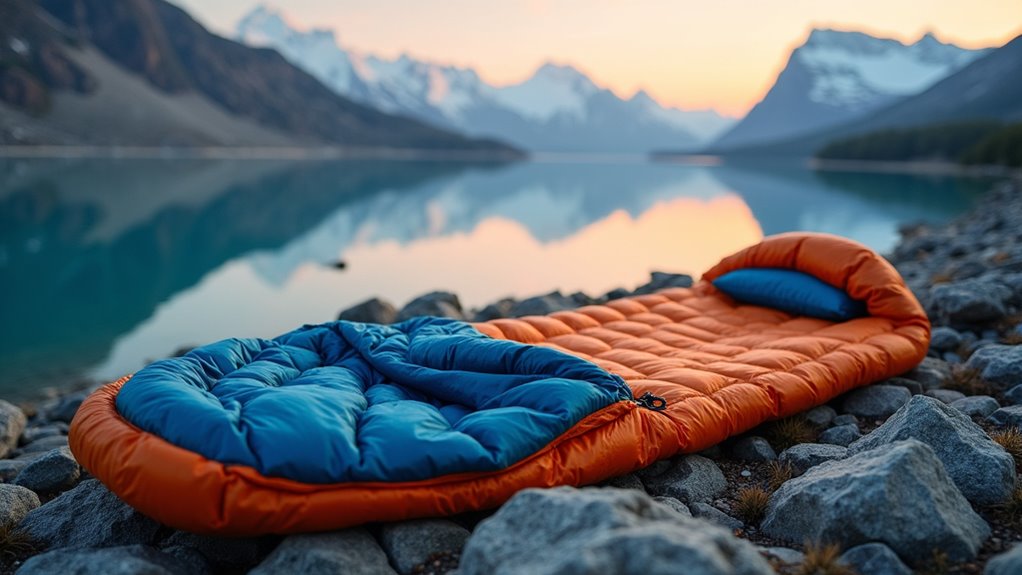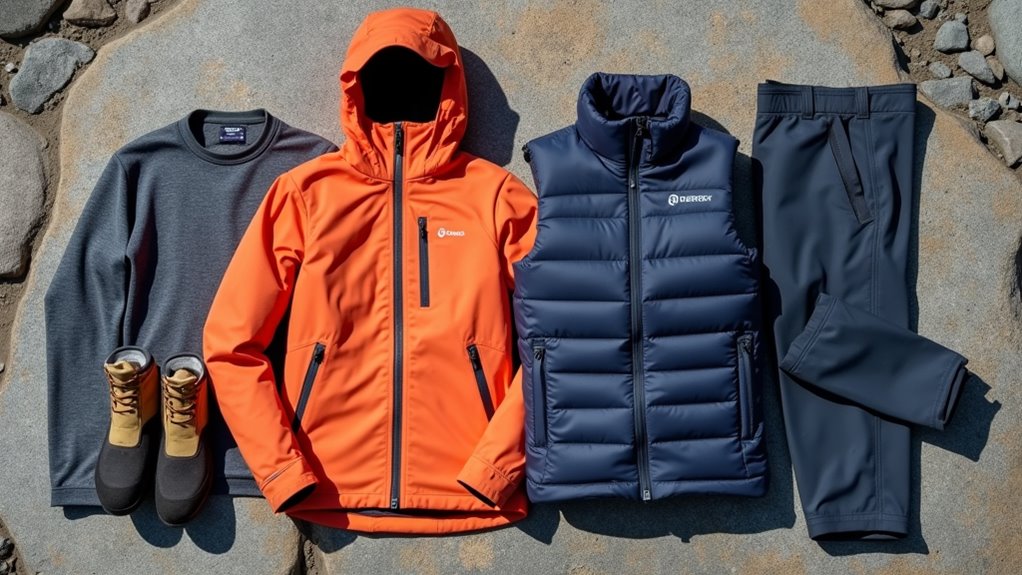Physical Address
304 North Cardinal St.
Dorchester Center, MA 02124
Physical Address
304 North Cardinal St.
Dorchester Center, MA 02124

From survival essentials to comfort upgrades, discover the 8 crucial gear pieces that separate successful outdoor adventures from dangerous ordeals.
Your backpack becomes the lifeline between civilization and wilderness – the difference between a memorable adventure and a survival ordeal. You don’t need to spend a fortune on gear, but you can’t afford to skimp on the essentials that’ll keep you safe and comfortable out there. Smart choices in eight key categories will transform your outdoor experience from potentially dangerous to genuinely enjoyable. Here’s what you absolutely can’t leave behind.

When you’re selecting a backpack for camping and hiking, think of it as choosing your portable home—it’ll carry everything you need to survive and thrive in the wilderness. Look for adjustable torso lengths and padded hip belts that’ll distribute weight properly. You don’t need the most expensive pack—focus on durability and comfort instead.
For day hikes, a 20-30 liter pack works perfectly. Multi-day trips require 40-70 liters, depending on your gear and trip length. Check for multiple compartments, external attachment points, and water-resistant materials.
Try on different brands since sizing varies considerably between manufacturers. Test your loaded pack before heading out. A properly fitted backpack should feel like an extension of your body, not a burden you’re wrestling with all day.
Your shelter system forms the critical barrier between you and whatever nature throws your way—from unexpected downpours to bone-chilling winds. You’ll need a reliable tent that balances weight, durability, and weather protection. Look for features like waterproof ratings above 3000mm, sealed seams, and sturdy zippers.
Don’t overlook your sleeping setup—a quality sleeping bag rated for expected temperatures and an insulating pad that prevents ground chill. You can save money by choosing synthetic insulation over down if you’re hiking in wet conditions.
Consider a lightweight tarp as backup shelter or cooking area. It’s versatile and weighs almost nothing.
Before making your final decision, evaluate your specific camping needs including group size, seasonal conditions, and transportation method to ensure your tent selection meets all your outdoor requirements.

Once you’ve secured a good night’s sleep in your shelter, the next morning brings the challenge of staying on track through unfamiliar terrain. Don’t rely solely on your smartphone’s GPS – batteries die and signals fail in remote areas.
A reliable compass and topographic map remain your most dependable navigation tools. Learn basic compass skills before your trip; they’re simpler than you’d think. Consider a GPS device as backup, but choose models with long battery life and replaceable batteries.
Download offline maps to your phone as an additional safety layer. Mark key waypoints and study your route beforehand. Trail markers and blazes help, but weather can obscure them.
Always inform someone of your planned route and expected return time. When planning a family camping trip, involve everyone in route planning to ensure the trail difficulty matches all skill levels and keeps the adventure enjoyable for every family member.
After you’ve mastered navigation basics, securing clean drinking water becomes your next critical survival skill. You’ll need reliable filtration equipment since natural water sources often contain harmful bacteria and parasites.
A lightweight water filter like the Sawyer Mini offers excellent value, removing 99.99% of contaminants for under $25. It’s compact and processes thousands of gallons.
For backup, pack water purification tablets—they’re cheap insurance against filter failure.
Don’t forget proper hydration gear. A durable water bottle or hydration bladder keeps filtered water accessible. Collapsible bottles save pack space when empty.
Consider electrolyte tablets too; they’ll help you maintain proper mineral balance during strenuous hikes.
Always carry more filtration capacity than you think you’ll need. Both water filters and purifiers serve essential roles in ensuring safe drinking water throughout extended camping expeditions.
Dehydration kills faster than most outdoor dangers.

While you can survive days without food and hours without water, quality sleep becomes non-negotiable after your first exhausting day on the trail. Your sleeping system consists of three critical components: sleeping bag, sleeping pad, and shelter.
Choose a sleeping bag rated 10-15 degrees below expected nighttime temperatures. Down offers superior warmth-to-weight ratios but loses insulation when wet. Synthetic fills cost less and perform better in moisture.
Don’t skimp on your sleeping pad—it’s your barrier against ground cold. Closed-cell foam pads are budget-friendly and puncture-proof, while inflatable pads provide superior comfort and insulation.
Your tent should withstand expected weather conditions. Three-season tents handle most conditions affordably, while ultralight options reduce pack weight but increase costs.
For high-altitude adventures like Mount Kilimanjaro, invest in four-season gear designed to handle extreme temperature drops and unpredictable mountain weather.
A good night’s sleep means nothing if you can’t fuel your body for the next day’s adventure. You’ll need reliable cooking gear that won’t break your budget or your back.
A lightweight camp stove with fuel canisters beats campfires for convenience and Leave No Trace principles. Look for compact models under $50 that’ll handle basic cooking tasks. Pack a single lightweight pot and spork – you don’t need a full kitchen set.
For food storage, bear canisters are mandatory in many areas, but rope and stuff sacks work elsewhere. Keep it simple with dried foods, instant meals, and energy bars.
A small cooler works for car camping, but backpackers should focus on non-perishables.
Smart food planning prevents waste and keeps costs down while ensuring you’ve got enough energy. When camping in colder conditions, your body burns more calories to maintain warmth, so winter camping requires additional meal planning to fuel your increased energy needs.

Since weather can turn dangerous without warning, your clothing choices become critical safety gear that doubles as comfort equipment. You’ll want to master the three-layer system: a moisture-wicking base layer, an insulating middle layer, and a waterproof outer shell.
Master the three-layer clothing system: moisture-wicking base, insulating middle, and waterproof shell—your critical safety gear for unpredictable weather conditions.
Skip cotton entirely—it retains moisture and loses insulation when wet. Instead, choose synthetic materials or merino wool for base layers. Fleece or down jackets work well for insulation, depending on your budget and conditions.
Don’t forget extremities. Pack a warm hat, waterproof gloves, and wool socks with extras. Quality rain gear prevents hypothermia and keeps you comfortable during unexpected downpours.
Buy versatile pieces that work across seasons rather than specialized items. This approach saves money while ensuring you’re prepared for changing conditions throughout your adventure. Consider whether renting or buying expensive outdoor gear makes more financial sense for occasional adventurers versus frequent hikers.
When emergencies strike in remote locations, your first aid kit becomes the difference between a minor setback and a dangerous situation. You’ll need bandages, antiseptic wipes, pain relievers, and medical tape for basic wound care.
Don’t forget blister treatment—moleskin or blister patches can save your hike. Pack emergency medications like antihistamines and any personal prescriptions.
Your emergency supplies should include a whistle for signaling help, emergency blanket for warmth, and headlamp with extra batteries. A multi-tool provides versatility for unexpected repairs.
Consider adding duct tape, which fixes everything from torn gear to makeshift splints.
Pre-made first aid kits offer convenience, but building your own guarantees you’ve got exactly what you need without paying for unnecessary items. A well-stocked first aid kit can transform your camping adventure from potentially dangerous to confidently prepared.
You’ll transform from a weekend warrior into an unstoppable outdoor legend with these eight game-changing essentials! Don’t let Mother Nature catch you unprepared – she’s ruthless and won’t give you a second chance. These budget-friendly basics aren’t just gear; they’re your lifeline to epic adventures and safe returns home. Skip even one item, and you’re practically signing up for disaster. Gear up smart, adventure harder, and conquer every trail like the outdoor champion you’re meant to be!